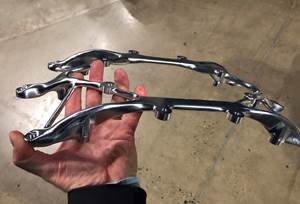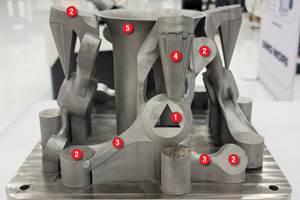NC Lessons Learned Apply to Additive Manufacturing
Just as numerical control of the 1960s had much room for growth, so do the additive manufacturing machines of today.
Subtractive manufacturing (SM) methods have been around ever since humans could whittle a block of material to create something useful. Consider Native Americans who chipped away at a piece of obsidian to form a stone knife or arrowhead. Methods have improved, obviously, but the concept behind subtractive manufacturing has remained the same for thousands of years: Remove material from an object to create something we need or want.
Circumstances surrounding additive manufacturing setups, like this one, mirror those of the early days of NC machining.
Additive manufacturing (AM), by comparison, is relatively new. It requires the placement of material on an empty plate or table. The process starts with nothing and, by solidifying powder, resin or filament, uses a layering process to create the desired item.
Though additive and numerical control (NC) subtractive processes are very different, they share several things in common. I have been around for much of the evolution of NC and CNC, so I would like to share a few observations in this regard.
How Early AM Is Like Early NC
Early NC machines (circa 1965) presented manufacturing companies with new challenges. Some were application-based; others required a shift in manufacturing culture. The same is true for today’s AM machines. While today’s technologies are light-years ahead of what they were fifty years ago, AM is in much the same place as NC was during the 1960s. Some interesting parallels include:
- Confusion and misconceptions: Today’s manufacturing engineers are struggling just as much to understand what is possible with AM machines as the engineers of the 1960s struggled to understand NC machines. The new terminology coupled with methodology and application possibilities make it difficult to separate what can be done from what is not possible and/or feasible.
- Application constraints: Early NC machines had limited capabilities that kept them from being universally accepted, as do today’s AM machines. Many of today’s companies have the same wait-and-see attitude about AM as did those hesitating to purchase their first NC machines so many years ago.
- Fear of obsolescence: The technologies surrounding AM are rapidly changing, just as they did with early NC. A real possibility exists that a newly purchased machine will not be competitive with a machine purchased just a few months later.
- The impossible made possible: NC dramatically simplified the task of producing the complex surfaces required for aircraft components, often making it possible to create surfaces that were previously impossible to machine without some kind of hand-made template or pattern. In like fashion, the first companies using AM to produce functional components (not just prototypes) often have no other feasible way to produce their parts.
- Reluctance to change: Regardless of the point in time, it may seem fruitless to rethink a process when proven methods are in place. And there is the “we’ve always done it that way” mindset. Just as many of the companies in the early days of NC had good applications for NC but did not act on them, lots of manufacturers today have great applications for AM but are not pulling the trigger.
Engineering Lessons
Another way AM parallels NC is related to engineering. Today’s design and manufacturing engineers are dealing with the same challenges that faced engineers in the early days of NC.
With the advent of NC came the ability to produce components with attributes that were previously impossible. While AM does require a design engineer to deal with or design around certain limitations, like minimizing the need for support structures, it also enables creation of components that would be impossible to produce using SM methods. Consider, for instance, small cooling holes in a complex manifold. AM allows holes in any location, of any length and following any path. These holes would be impossible for a drill to produce even with the best of today’s CNC machines.
Similarly, today’s manufacturing engineers are facing a shift in duties like the ones experienced when NC was in its infancy. Just as engineers in the early days of NC had to rethink their methods to be able to transfer processes from conventional machines to NC machines, so must today’s engineers adjust to the changes required to produce components using AM. Frankly speaking, AM should make a manufacturing engineer’s job easier. There is no special workholding or tooling to be designed and fabricated. All that is required to produce a component with AM is the machine, the 3D model and the raw material (filament, resin or powder). And while there may be postprocess work to be done after the AM process (sintering, for example), the overall process for producing a component using AM is dramatically simplified.
A Manufacturing Prediction
Just as numerical control of the 1960s had much room for growth, so do the AM machines of today. Indeed, I believe AM is where NC was back then — only a small percentage of companies are using AM to produce production components, just as only a few companies used early NC machines. But just as NC has grown to the point that almost every company that manufactures anything has at least some CNC machines, I predict that, eventually, almost every manufacturer have some form of AM equipment.
Related Content
Using Topology Optimization to Lightweight: A Paradox for Machining
Today’s computer software can just as easily generate lightweight shapes for subtractive processes as it can for additive ones, but it increases cost and waste to make them.
Read More5 Tips for Getting the Most From the Historic Return of North America’s Biggest Manufacturing Event
Plan. Explore. Think of the future. And oh yeah, the shoes. Here is how to get the most from the major manufacturing event that none of us have experienced in four years, and that many will be experiencing for the first time.
Read MoreDesigning a 3D Printed Part with Machining in Mind
Designing extra stock and mounting features into a 3D printed part can aid in machining processes downstream.
Read MoreThe Benefits of Vertically Integrating Metal 3D Printing and Machining
Having 3D printing and machining within one organization enables Addman’s engineers to collaborate and consolidate so it can quickly make successful metal 3D printed parts.
Read MoreRead Next
The Cut Scene: The Finer Details of Large-Format Machining
Small details and features can have an outsized impact on large parts, such as Barbco’s collapsible utility drill head.
Read MoreObscure CNC Features That Can Help (or Hurt) You
You cannot begin to take advantage of an available feature if you do not know it exists. Conversely, you will not know how to avoid CNC features that may be detrimental to your process.
Read More3 Mistakes That Cause CNC Programs to Fail
Despite enhancements to manufacturing technology, there are still issues today that can cause programs to fail. These failures can cause lost time, scrapped parts, damaged machines and even injured operators.
Read More
.jpg;width=70;height=70;mode=crop)












.png;maxWidth=300;quality=90)

.png;maxWidth=300;quality=90)











